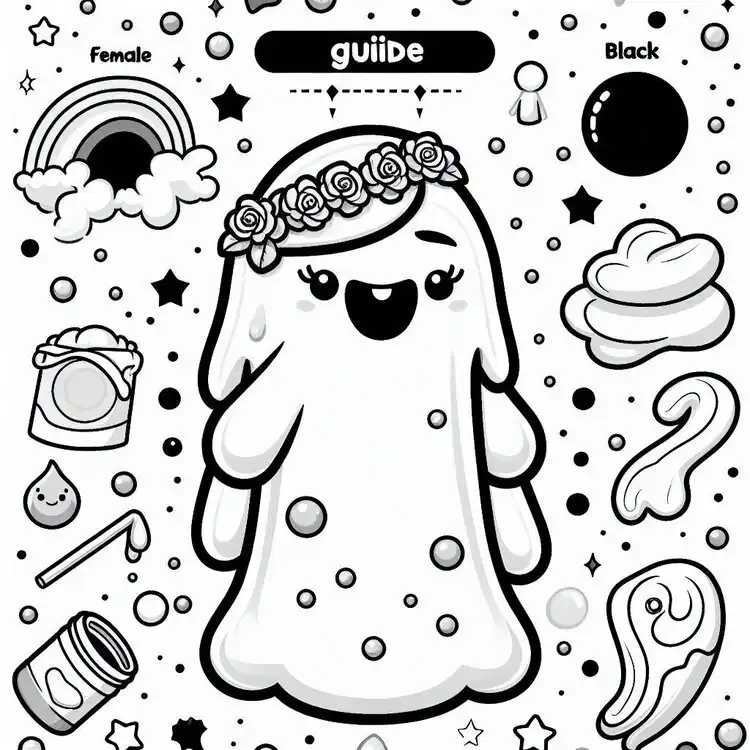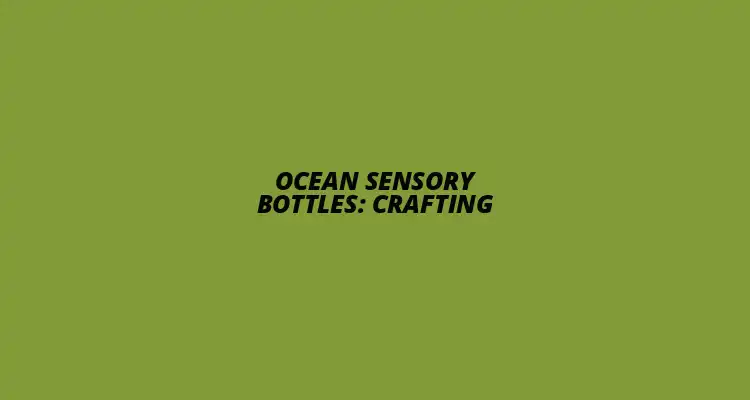
- Crafts & DIY
- Jul 26
2024-06-11
Introduction to Ocean Sensory Bottles
Sensory bottles offer a world of exploration and fascination for toddlers and preschoolers alike. These simple yet captivating creations serve not only as sources of entertainment but also as valuable tools for calming restless minds and sparking curiosity. Among the myriad options in sensory play, ocean sensory bottles stand out for their ability to immerse young learners in the wonders of the sea.
TIP: Display your child’s artwork at home to boost their confidence and pride.
Ocean sensory bottles introduce children to the enchanting realm of marine life while engaging their senses and nurturing their creativity. As a versatile activity, crafting these sensory bottles provides an opportunity for educational enrichment, whether as part of a structured learning unit or simply for leisure at home.
Benefits of Ocean Sensory Bottles
Calming Effects: The rhythmic motion of swirling water and floating objects within the bottle can have a soothing effect on children, promoting relaxation and tranquility during quiet times or before bedtime.
Sensory Stimulation: Ocean sensory bottles stimulate various senses, including sight, touch, and proprioception, as children observe the movement of objects, feel the textures of sea creatures, and manipulate the bottle to create waves.
Educational Value: Through hands-on exploration, children learn about marine life, ocean habitats, and concepts such as buoyancy and density. Ocean sensory bottles also facilitate language development as caregivers engage children in discussions about the sea creatures and their characteristics.
Internal Link: One of the best activities for kids during summer is playing with water tables. These tables offer endless fun and educational opportunities.
In the next section, we delve into the materials and preparation needed to embark on the adventure of crafting ocean sensory bottles.
Sourcing Voss Water Bottles
When embarking on the journey of crafting ocean sensory bottles, the first essential step is acquiring the perfect vessel for your creation. Voss water bottles are favored for their clear cylindrical shape and wide openings, ideal for showcasing the captivating contents of the sensory bottle.
Tips for Locating Voss Water Bottles
Local Stores: Begin your search for Voss water bottles at nearby grocery stores, specialty beverage shops, or health food stores. While availability may vary depending on location, these establishments often carry premium bottled water brands like Voss.
Online Retailers: If local stores don't stock Voss water bottles, don't fret. Online retailers such as Amazon offer a convenient solution, allowing you to browse and purchase Voss bottles from the comfort of your home. Simply navigate to your preferred online marketplace and search for Voss water bottles to explore various purchasing options.
Importance of Wide Bottle Openings
The wide openings of Voss water bottles serve a dual purpose in the creation of ocean sensory bottles. Firstly, they provide ample space for inserting sea creatures, shells, and other decorative elements, enabling you to create visually stunning underwater scenes. Secondly, the wide openings facilitate the addition of water and baby oil, ensuring a smooth and hassle-free assembly process.
Decorating the Bottle

Once you've secured your Voss water bottles, it's time to unleash your creativity and personalize each bottle to reflect the beauty of the ocean. Whether you're crafting ocean sensory bottles for educational purposes or simply for aesthetic pleasure, decorating the exterior of the bottle adds an extra layer of charm to the final creation.
Utilizing Stickers and Markers
Ocean Stickers: If you're short on time or prefer a hassle-free decorating method, opt for ocean-themed stickers. These adhesive decals feature an array of marine creatures, waves, and underwater scenery, instantly transforming plain bottles into captivating works of art.
Glass Markers and Liquid Chalk Markers: For a hands-on approach to decoration, unleash your artistic talents with glass markers or liquid chalk markers. These versatile tools allow you to draw intricate designs directly onto the surface of the bottle, from colorful coral reefs to playful sea creatures.
Suggestions for Decoration Themes
Fish and Sea Creatures: Bring the ocean to life by adorning your sensory bottles with an assortment of fish, dolphins, sea turtles, and other marine inhabitants.
Waves and Bubbles: Create a sense of movement and depth by adding swirling waves, frothy bubbles, and cascading water droplets to the exterior of the bottle.
In the next section, we'll explore the process of adding sea creatures to your ocean sensory bottles, transforming them into captivating underwater worlds.
Adding Sea Creatures
Once you've gathered your materials and prepared the bottle, it's time to infuse your ocean sensory creation with captivating sea creatures and shells. This step not only enhances the visual appeal of the sensory bottle but also provides an excellent opportunity for interaction and vocabulary building with toddlers and preschoolers.
Guidance on Selecting Sea Creatures
Don't miss our detailed exploration on Everything you need to know about diy advent calendars kids, where we delve into all the aspects of this fascinating topic. It's packed with valuable insights and practical tips.
When selecting sea creatures and shells for your sensory bottle, consider factors such as size, texture, and durability. Opt for a variety of shapes and colors to create a diverse underwater environment that sparks curiosity and imagination. Here are some popular options to consider:
Plastic Sea Creatures: Plastic sea creatures are widely available and come in assorted packs featuring fish, dolphins, sharks, and more. Choose creatures that are appropriately sized for the bottle opening and safe for young children.
Natural Sea Shells: Collecting shells from the beach or purchasing them from craft stores adds an authentic touch to your sensory bottle. Look for shells with interesting textures and patterns to add visual interest and tactile stimulation.
Encouraging Interaction and Vocabulary Building
As you add sea creatures and shells to the bottle, engage children in conversation about each item. Encourage them to identify different creatures, describe their characteristics, and mimic their movements. This interactive process not only fosters language development but also deepens their understanding of marine life and the ocean ecosystem.
Preparing the Waves
Before sealing the bottle, it's essential to create the illusion of ocean waves by filling it with a combination of water and baby oil. This simple yet effective technique enhances the sensory experience and adds an element of magic to the bottle.
Instructions for Filling the Bottle
Water: Begin by filling the bottle halfway with water, ensuring that there is enough space left to accommodate the sea creatures and shells without overcrowding.
Baby Oil: Next, add baby oil to the bottle, filling it almost to the top. The baby oil will float on top of the water, creating a distinct separation between the two liquids and mimicking the appearance of ocean waves.
Our blog post on Discover the details of pumpkin crafting templates is a must-read for anyone interested in the subject. It’s filled with comprehensive details and thoughtful perspectives.
Explaining the Role of Baby Oil
Baby oil serves as a key ingredient in creating the wave-like effects inside the sensory bottle. Its lighter density compared to water allows it to float on the surface, forming distinct layers that undulate and shift with movement. As children manipulate the bottle, they'll observe mesmerizing wave patterns that evoke the tranquility of the ocean.
In the next section, we'll explore the final steps of sealing the sensory bottle and facilitating interactive playtime for toddlers and preschoolers.
Sealing and Enjoying the Sensory Experience
Don't miss our detailed exploration on Understand mothers day coloring pages kids, where we delve into all the aspects of this fascinating topic. It's packed with valuable insights and practical tips.
Now that your ocean sensory bottle is filled with captivating sea creatures and swirling waves, it's time to seal it securely and embark on an enchanting sensory journey with your little ones.
Sealing the Bottle
Properly sealing the sensory bottle is crucial to prevent leaks and spills during playtime. Follow these steps to ensure a tight seal:
Secure Cap: Tighten the cap of the bottle securely to prevent any liquid from leaking out. Ensure that the cap is screwed on tightly to avoid any accidents.
Optional Safety Measures: For added security, you can cover the bottle top with tape to provide an extra layer of protection. Simply wrap a piece of tape around the cap to secure it in place. This step is especially useful if you anticipate vigorous shaking or handling of the bottle during play.
Interactive Playtime
With the sensory bottle securely sealed, it's time to invite toddlers and preschoolers to engage in interactive play. Here are some suggestions for making the most of this sensory experience:
Shake and Explore: Encourage children to shake the bottle gently and observe the swirling patterns created by the sea creatures and waves. As they watch the mesmerizing motion inside the bottle, they'll be captivated by the sensory stimulation and visual delight.
Language Development: Use the sensory bottle as a tool for language development by encouraging children to describe what they see. Prompt them to identify different sea creatures, describe their colors and movements, and narrate imaginary stories about life underwater. This interactive dialogue fosters vocabulary building and imaginative thinking.
Sensory Exploration: Explore the tactile and visual elements of the sensory bottle by encouraging children to touch and observe the various textures and shapes inside. As they manipulate the bottle, they'll experience different sensations and develop fine motor skills.
Sharing Experiences and Testimonials
As children immerse themselves in the sensory experience, take the opportunity to share personal experiences and testimonials to highlight the appeal of the activity. Whether it's recounting moments of wonder and discovery or expressing delight at seeing a child's imagination come to life, sharing real-life stories adds authenticity and relatability to your content.
By fostering a sense of connection and community through shared experiences, you create an engaging and inclusive environment where readers feel inspired to participate and contribute their own stories.
In conclusion, ocean sensory bottles offer a delightful blend of creativity, education, and sensory stimulation for toddlers and preschoolers. By following the steps outlined in this guide, you can create a captivating sensory experience that sparks curiosity, imagination, and joy in young children.
Join us in the sensory adventure! Share your experiences, ask questions, and explore more sensory activities on our website.
